In western Canada, a controversy brews once again over the capture and cull of herds of wild horses.
Bryn Thiessen is a cowboy, a rancher, a poet, and a preacher. Every Tuesday, he hosts a “cowboy church sermon” in the small town of Sundre, Alberta, an event he describes as a throwback to rodeo services with bluegrass western music. Roughly a hundred people usually show up. He dresses in a wide-brimmed felt hat, pink knot tie, vest, and cowboy boots. He is as honest and allergic to what he calls “PC talk” as he is polite. “I live by my own rules,” he says. If you ask him to tag along for a day on the land, he’ll meet you at the local donut shop and then drive you around in his truck, since most city cars can’t maneuver the mud bog that is the spring melt.
The ranches like Thiessen’s that nestle the Alberta foothills are generational dynasties, passed down from family member to family member—Helmer, Bergen, Bearberry, all connected by a road known as the Cowboy Trail. The ranches were settled when the West stretched along with the railroad, and they have been there ever since, huge, sprawling homesteads with farmhouses and barns, grazing land and hitch posts. Here, the past is rarely forgotten. As the plains sweep dramatically towards mountains, wild horses roam as if the land had never been settled.
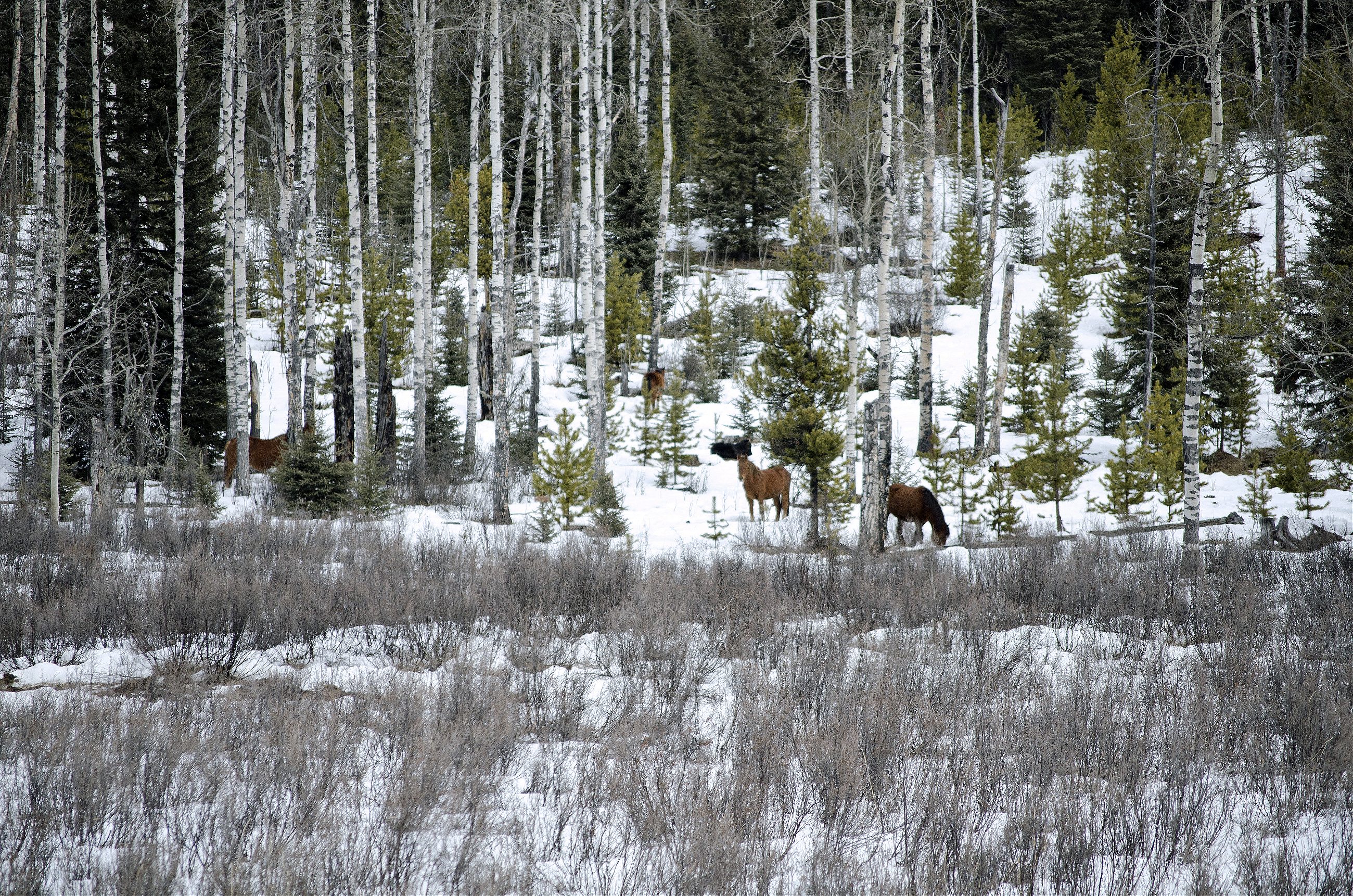
On an early-spring day in March, Thiessen drives his truck to Jason Bradley’s Red Deer River Ranch. Thiessen and Bradley are unlikely friends on the surface, linked more through their approach to wild horses than through their profession. As a rancher, Bradley is Thiessen’s opposite. He runs his modern operation wearing steel-toed boots and black athletic fleece, a dusty work coat and sunglasses. He speaks with the patter of a businessman and sends his daughters to university in Edmonton, Alberta’s capital. The cab of Thiessen’s truck is dusty, the floor covered in grass and wheat. The trailer bed is filled with bric-a-brac—empty pails, gas cans, chains, and shovels. But recently, the two are on a common mission, one that has made them controversial throughout this land: to set up a large capture pen, big enough for three or four full-grown horses and maybe a couple of colts, that they will use to catch wild horses.
This land that they are driving through—Bradley on his tractor, Thiessen following in his truck—is wild horse country. The grasslands at the base of the mountains, owned by the province of Alberta, are where you’re most likely to see small groups of wild horses huddled at the side of the road, on ridges or hills, crossing rivers and marshes. Often, there are too many horses on the land. Thiessen and Bradley are the only two Albertans to have secured a permit to capture wild horses and do with them what they will—either selling them to other horseowners, or in some cases, selling them for meat. For six weeks this winter, the two men became the focus of public protest and media scrutiny as the foothills became a battleground, yet again, for horse advocates and ranchers holding capture permits.
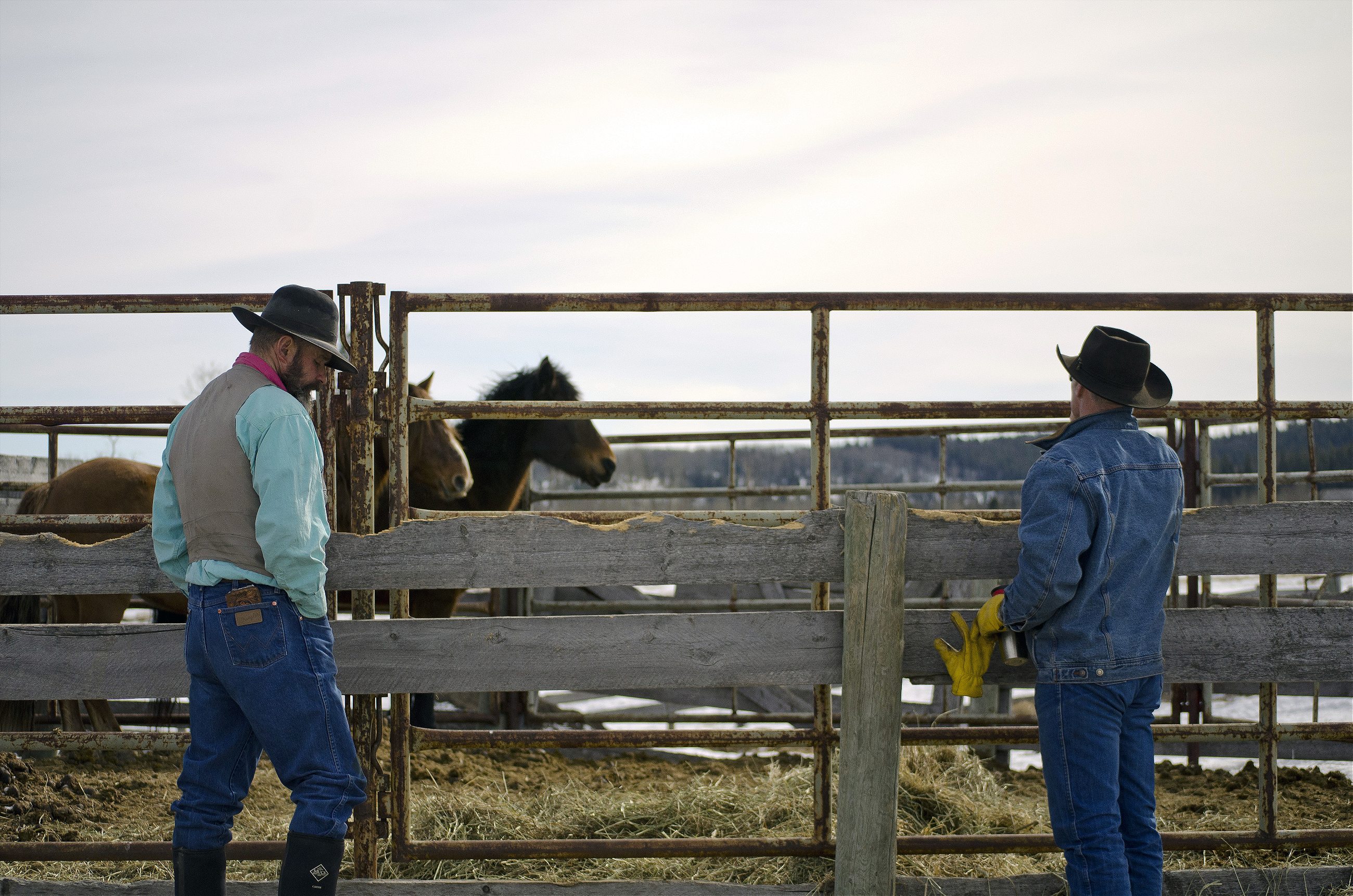
Considering the majestic sight of a band of horses stampeding across rolling hills at the foot of a mountain, the opposition is understandable. But there’s still a problem: the horses must eat. And what they eat is valuable grass on which cattle, elk and deer graze, leaving only rye grass behind. Rye grass is low in nutrients—horses won’t eat it and neither will cows. Right now, there are too many horses for the land to maintain while still leaving enough grass for the cattle.
The solution has been a controlled capture season, set by the Government of Alberta’s Environment and Sustainable Resources Development (ESRD) department. Those interested in capturing the horses have to apply for a $200 permit and maintain or rent their own pens. Each year, the ESRD decides if there will be a capture—they monitor the number of horses by flying overhead in winter, counting the brown specs on the white snow. This year, they counted just over 800, about 100 fewer than 2013. The 2013-2014 winter was so harsh that wild horse advocates campaigned hard against the capture—the weather should be enough, they thought, to naturally manage the herd. But late in the season, at the very end of the winter, ESRD handed out the permits.
They are wild by nature, but they are not technically remnants of an earlier time
Every few years, as political tides and public perception change, wild horses come back into the Albertan conscience. From the 1970s through the early-2000s, wild horse management was a hot button issue. The question was whether the province should even “manage” them at all. Wild horses have not been designated at-risk because Environment Canada considers horses to be an introduced species, as opposed to native. At one point, the capture had been indefinitely stopped. Now that it’s back, the dust has been kicked up once more.
Much of the debate surrounding wild horses lies in the language. Thiessen and Bradley call the horses “feral” (though they both sometimes use the slang term “wildie,” as well). A feral horse is a domestic that has escaped or been released into the wild. The argument is that there are no more truly wild horses left on this land. Hundreds of years ago, when North America was first being settled, millions of Spanish mustangs and British thoroughbred horses were brought over to help. Many ran free. They roamed the foothills, below the mountains, and never returned.
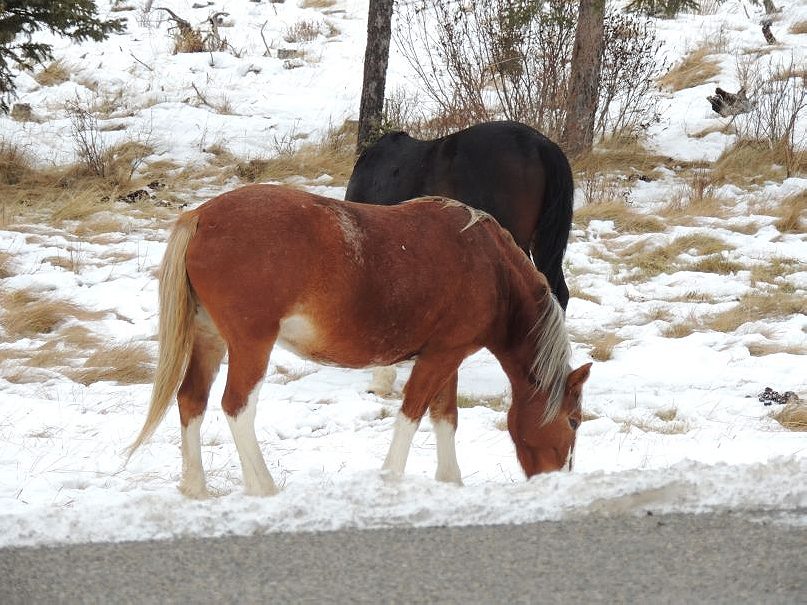
It’s unlikely that today’s wild horses are true descendants of those original wildies—in the 1970s, it was estimated that less than 1,000 of the current wild horse population were truly “wild.” Instead, they are a mixture of domesticated, work, and outfitter horses that had, at some point, been set free and managed to survive. They are wild by nature, but they are not technically remnants of an earlier time. “You could shake an oat pail,” Thiessen says, “and they’ll come up to you.”
There is also horse overpopulation in the United States, which has very little regulation over the price, management, and sale of the horses. It’s estimated that there are over 15,000 wild horses in the U.S., with the vast majority living in Nevada.
You could ride one if you captured it and decided to train it, but “it’s like riding a Dodge with no tires”
On Bradley’s property there are two horses in a pen, and Thiessen points out certain traits that qualifies them as wildies: they have evolved over time to survive in the bush, rather than bred to look good and for humans to ride. They have the look of a Shetland pony—short, stout, strong but not sleek. They have evolved to climb hills and cross bogs, they can run through the bush backwards. You could ride one if you captured it and decided to train it, but “it’s like riding a Dodge with no tires,” Thiessen says. Bradley has had some interest from horse hobbyists in British Columbia and Manitoba who would like to buy the horses and the one filly he has also kept.
North of Bradley’s property, a gate blocks off the land on which wild horses and cattle graze. (A few weeks before, protestors had camped in front of the gate, setting fires and blocking the road). The metal pen is a half hour ride from here, over hills and wetlands, deep in the foothills that face the mountains. Thiessen and Bradley drive along a steep, potholed ridge to get to where Bradley has set up the six-foot high pen where he traps them.
Arriving at the pen—a series of metal gates and trip wires—Bradley notes that one of the wires he had set up had been snapped, allowing the door to swing shut. Bradley and Thiessen had baited their pens with hay and grass and left the door open–when horses would find their way inside, they would knock a tripwire with their legs. The snapped wire would allow the door to shut, trapping them. Bradley suspects protestors cut it. It wouldn’t be the first time. He has a camera set up, just in case, which has shown protesters sneaking in at night in the past.
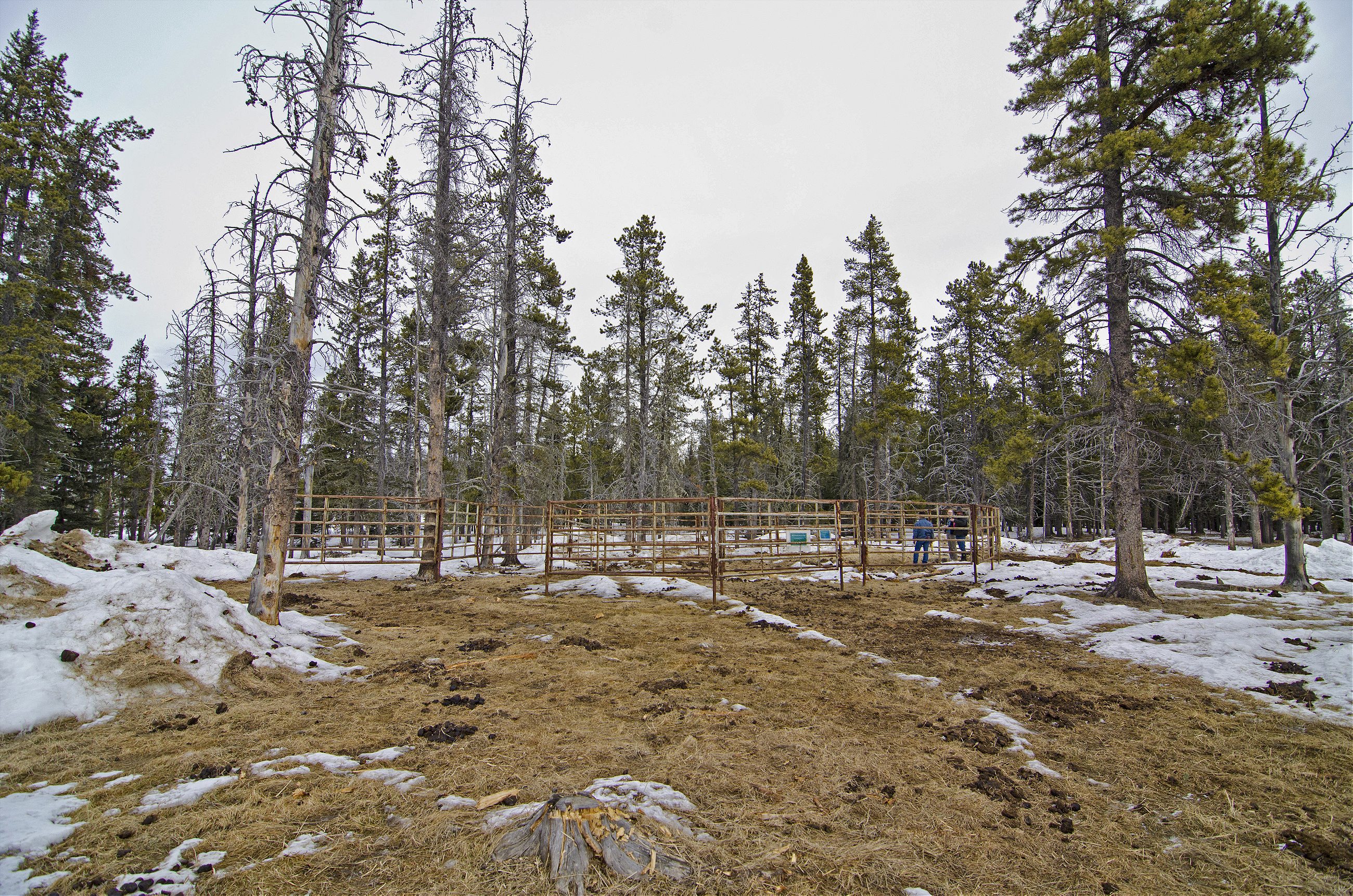
The province is careful not to call the management a “cull”; they allow the horses to be captured through permit, leaving the fate of the animals in the hands of the permit holder. In total, Bradley and Thiessen—the only two people who applied for permits—caught 15 horses and one colt. For Bradley, this amounted to about one horse every two days. He would head out to the pen early at dawn and load any caught horses into a trailer, a slow and steady process that could take hours. Sometimes, the horses bucked and kicked the entire way back to his property. When he got back, “I’d have a coffee,” he says.
Bradley and Thiessen both began fielding calls from farm owners and buyers from across the country, all interested in owning a “wildie.” Most of the horses sell for $350 to $500—a bargain considering how much effort goes into catching them. Normally, they’re bought for sentimental reasons, as opposed to for breeding, which commands the serious money. The true beauty of a wildie lies in its history, not its appearance. In the U.S., the price for wild horses varies greatly. Adoption fees in the U.S. are a little lower than $200, but private sales can net much more. In Fort Worth, Texas, the Extreme Mustang Makeover—a sort of pageant for adopted wild horses—offers a prize of $50,000.
The horse capture season’s most vocal critic is the Wild Horses of Alberta Society (WHOAS), which has taken its campaign to social media and blogs. Bob Henderson, the society’s co-founder, often refers to the horses as “your wildies.” Henderson and WHOAS didn’t respond to interview requests, but they were vocal during the capture season. “Why are we killing our horses? We live in Alberta. We pride ourselves on horse culture,” said one, to the national Globe and Mail newspaper.
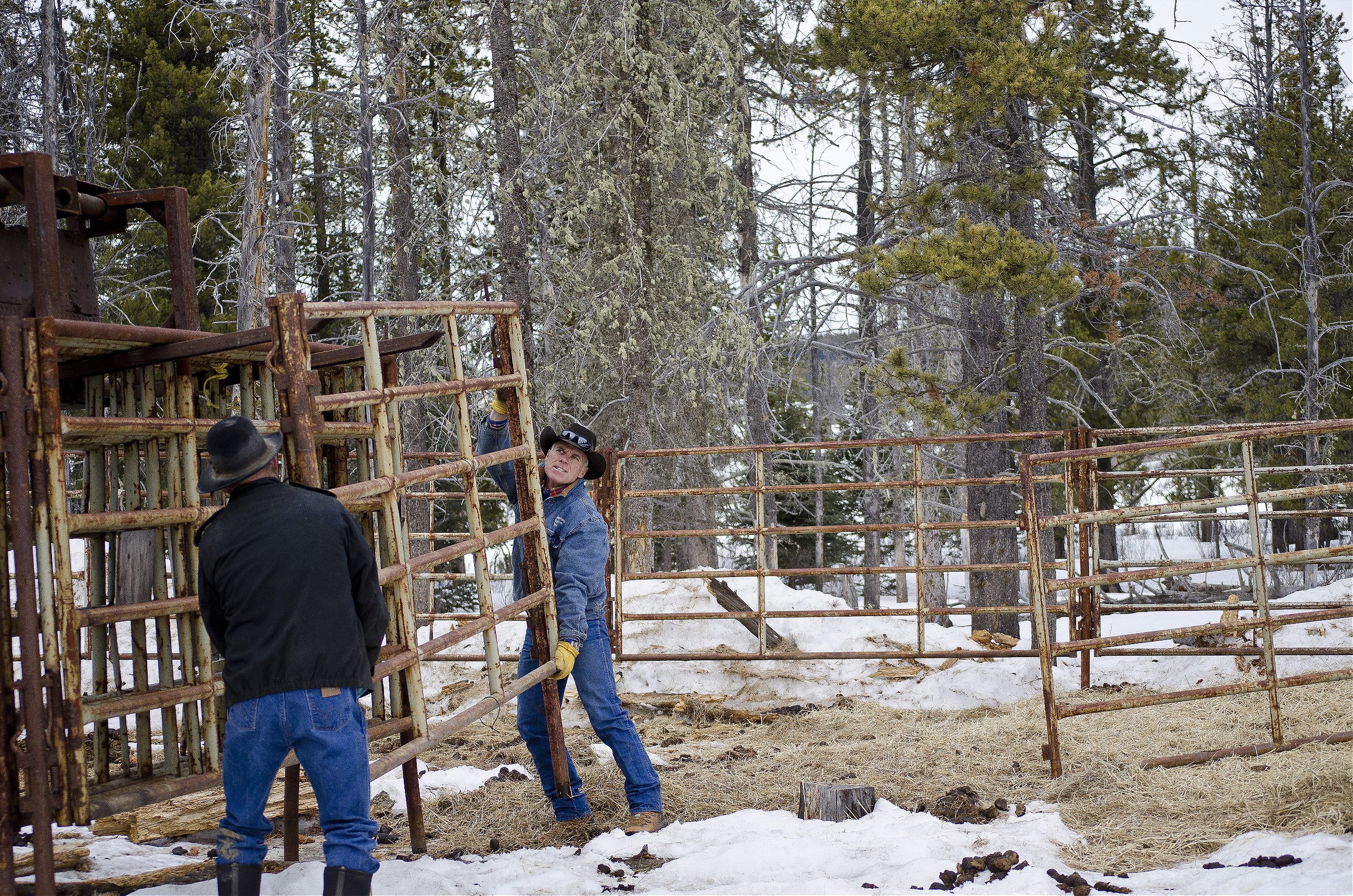
The controversy has mirrored some of the same debates in the U.S., where the number of wild horses is much larger, and the Bureau of Land Management alone is responsible for capturing and adopting them out. The BLM methods, which have evolved from poisoning well water to the current preference for helicopter roundups, are still drawing criticism for the number of animals injured during capture, not to mention the high costs of permanently housing the animals who don’t get adopted. But the U.S. government is at least prohibited from selling horses for horsemeat, so the controversy in Canada is, if anything, a bit sharper.
Thiessen resents the emotional tone of the protestors’ fawning over the wildies. “I can’t stand the rhetoric,” he says. He is dismissive of his critics—“It’s middle-aged women and teenage girls”—and their motivations.
Bradley has taken the brunt of the protestors’ anger. Comments on the WHOAS blog accuse him of having too much influence on government decision-making, that his voice is too loud during the annual consultation process. A typical comment on the blog accused Bradley of “blatant conflict of interest” for being both a license-holder and a member of the steering committee that makes recommendations about capture limits.
In February, when the capture season ramped up, dozens of protesters congregated outside Bradley’s gate
“They have assumed that everything I’m doing this year, everything I’m doing is wrong or illegal or outside the regulation,” Bradley says. In February, when the capture season ramped up, dozens of protesters congregated outside Bradley’s gate, camping out for weeks and loitering around (though not disturbing) the capture pen. Five people were eventually arrested for mischief.
The government doesn’t keep a tally on what happens to each captured horse, but most of the horses Thiessen and Bradley caught this year were sold to buyers in Manitoba and British Columbia. Thiessen was considering keeping and taming one for himself, and Bradley hung on to the colt he had kept in his pen. Sometimes, owners will breed a wildie with one of their own mares or stallions. But lots of horses are sent to slaughterhouses, including to one south of Sundre, in Fort Macleod, Alberta, that processes horse meat. There, the horse itself will sell for about 25 cents per pound.

Authorities are currently looking for a solution to appease both parties, including the use of hormonal birth control. At an open house this year, two researchers presented a solution that would include darting and sedating the horses, administering birth control, and then tracking them. Thiessen is skeptical. “At what point do they cease to become a wild animal and become a lab rat?” he says. Some WHOAS members advocate more aggressive attempts at finding people willing to adopt the horses.
There is another, perhaps more pressing concern: the wild horses are being slowly desensitized to human presence. Tourist groups ride domesticated horses into the backcountry, looking to spot wildies.
On our way back to Bradley’s, after taking down the pen, we spot two groups of horses. One is barely noticeable, a blur on the hillside. A second group stood next to the road; among them is an easily recognizable horse that protestors have dubbed White Spirit.
We pull up next to them in Thiessen’s truck. The horses don’t even spook.